MARIANI’S
October
11, 2009
NEWSLETTER
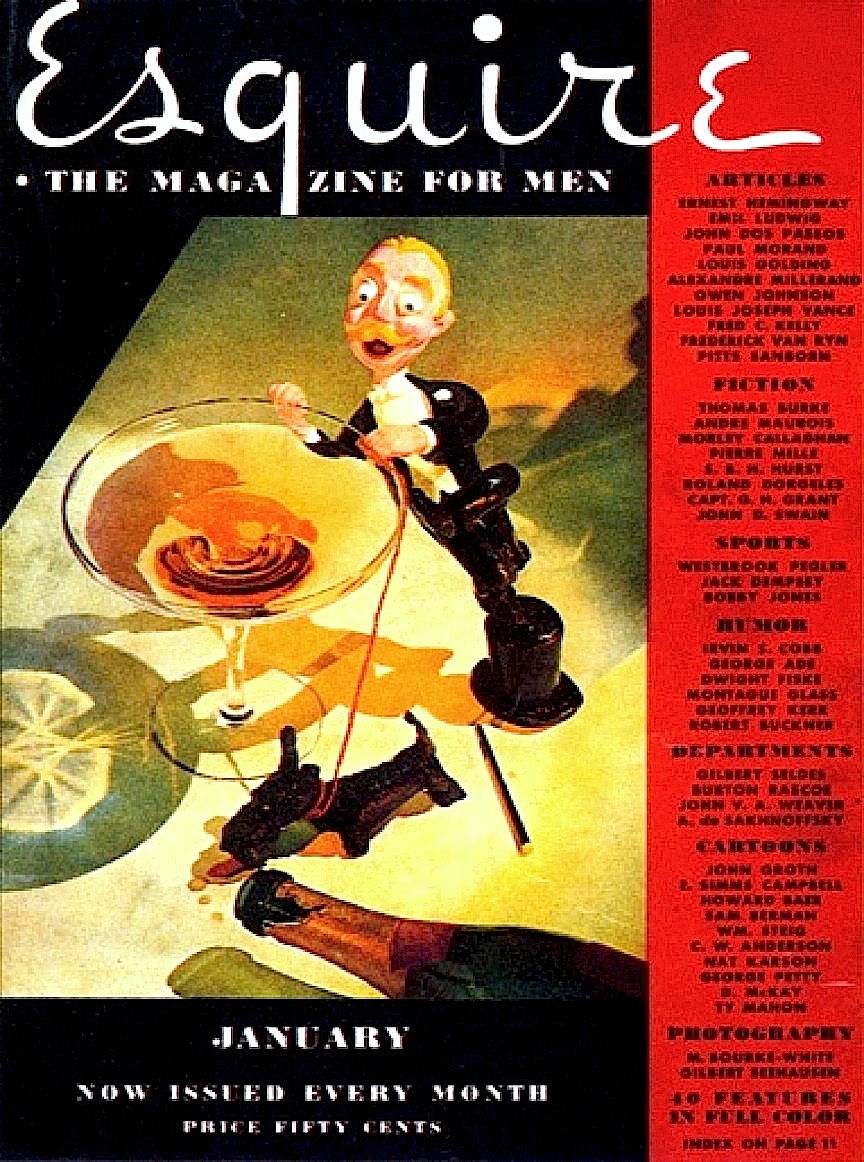
Esquire Magazine cover
1934
~~~~~~~~~~~~~~~~~~~~~~~~~~~~~~~~~
➔ QUESTIONS? TO REACH JOHN MARIANI
WRITE
TO: newsletter@johnmariani.com.
➔ ARCHIVE: Readers may now access
an
Archive of all past newsletters--each annotated--dating back to July,
2003, by simply clicking on www.johnmariani.com/archive
➔ SUBSCRIBE AND
UN-SUBSCRIBE: You may subscribe anyone you wish
to this newsletter--free of charge--by
clicking here.
~~~~~~~~~~~~~
☛ In
This Issue
ESQUIRE'S
BEST NEW
RESTAURANTS IN AMERICA 2009 by John Mariani
NOTES FROM THE WINE CELLAR: Champagne in All Its Bubbly Variety, Part I by Brian Freedman
QUICK BYTES
~~~~~~~~~~~~~
by John Mariani ➷
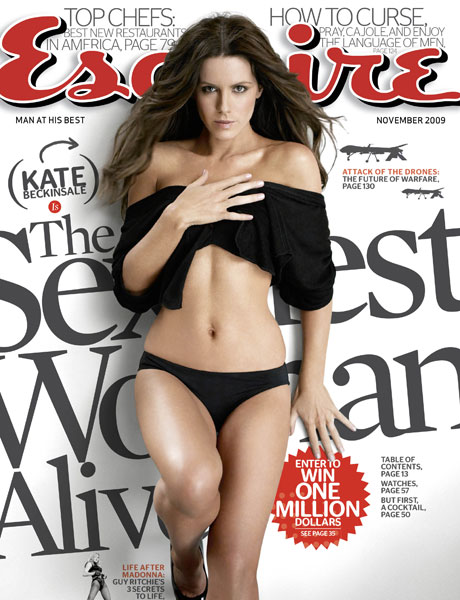
To make the list, a restaurant must:
1. Have opened after September 2008.
2. The restaurant cannot just be a relocation or new décor with the same chef.
3. The restaurant cannot be a branch of an original restaurant somewhere else.
4. The Chef must be a working chef, not one who merely puts his name on the door and rarely visits.
5. A distinctive style of food separates very good restaurants from innovative ones.
6. Atmosphere and comfort count far more than dazzling décor.
7. Prices should reflect the quality of food, décor, and service.
8. A wine or beverage list should reflect the kind of cuisine the restaurant serves.
➔ Here, then, are the winners for 2009 (in alphabetical order), followed by 4 Chefs to Keep Your Eye On and an added bonus this year--15 More Great New Restaurants You Don't Want to Miss.
AREA 31--The Epic Hotel, 270 Biscayne Boulevard, Miami; 866-781-9924; Chef John Critchley.
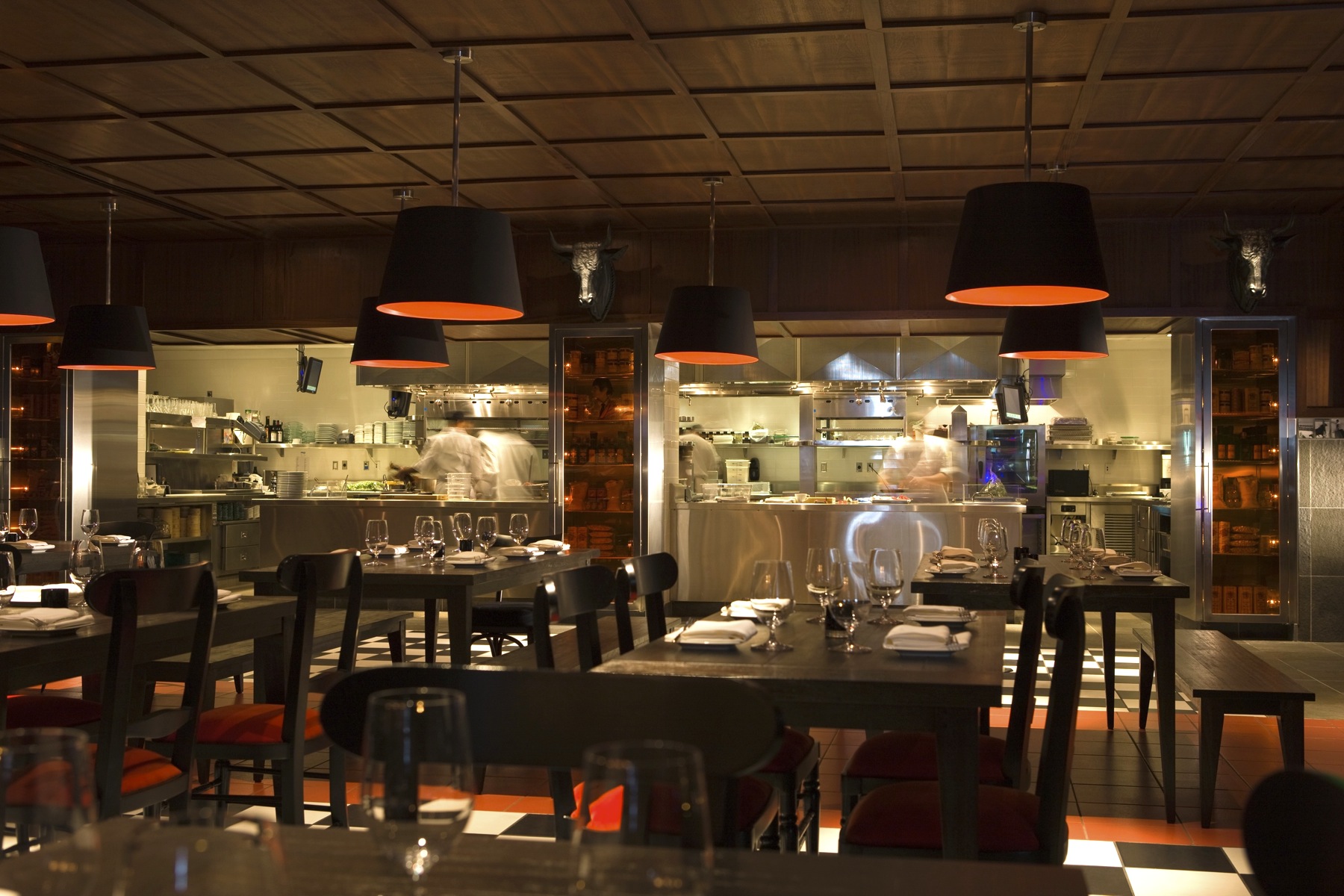
RESTAURANT OF THE YEAR: BAZAAR, SLS Hotel at Beverly Hills, 465 South La Cienega Blvd., Los Angeles; 310-246-5545; . Chef/owner José Andrés. (right).
THE BEDFORD POST INN--954 Old Post Road, Bedford, NY; 914-234-7800; . Chef Brian Lewis.
CHEF OF THE YEAR: BARTON SEAVER of BLUE RIDGE--2340 Wisconsin Ave NW, Washington, DC; 202-333-4004.
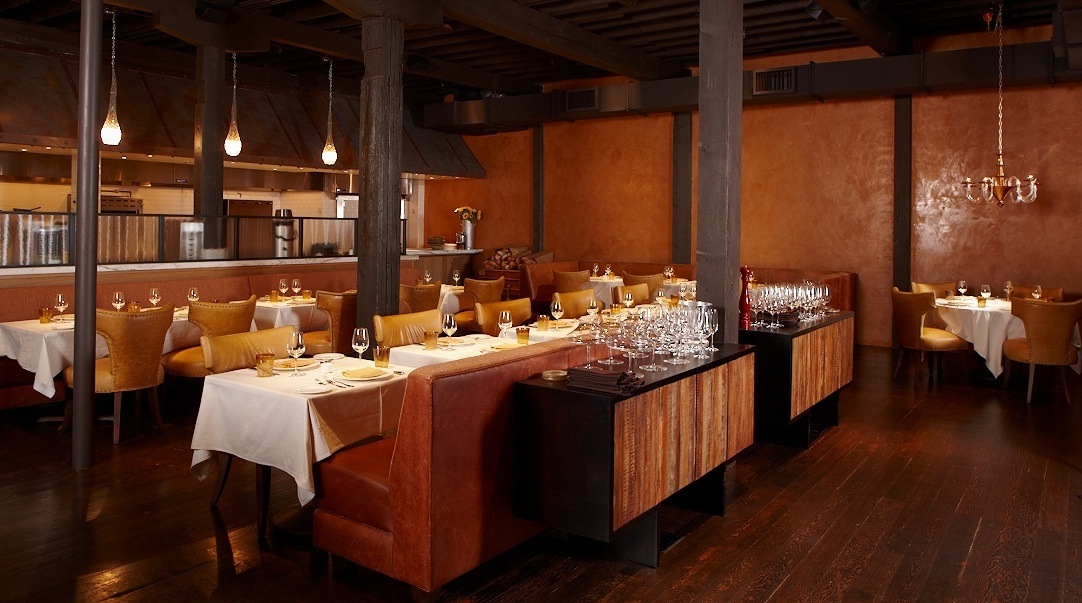
BOTTEGA--6525 Washington Street, Yountville, CA; 707-945-1050; Chef/owner Michael Chiarello. (left)
CORTON--239 W Broadway, NYC; 212-219-2777; Chef/owner Paul Liebrandt.
L’ALBATROS BRASSERIE & BAR--11401 Bellflower Road, Cleveland; 216-791-7880;
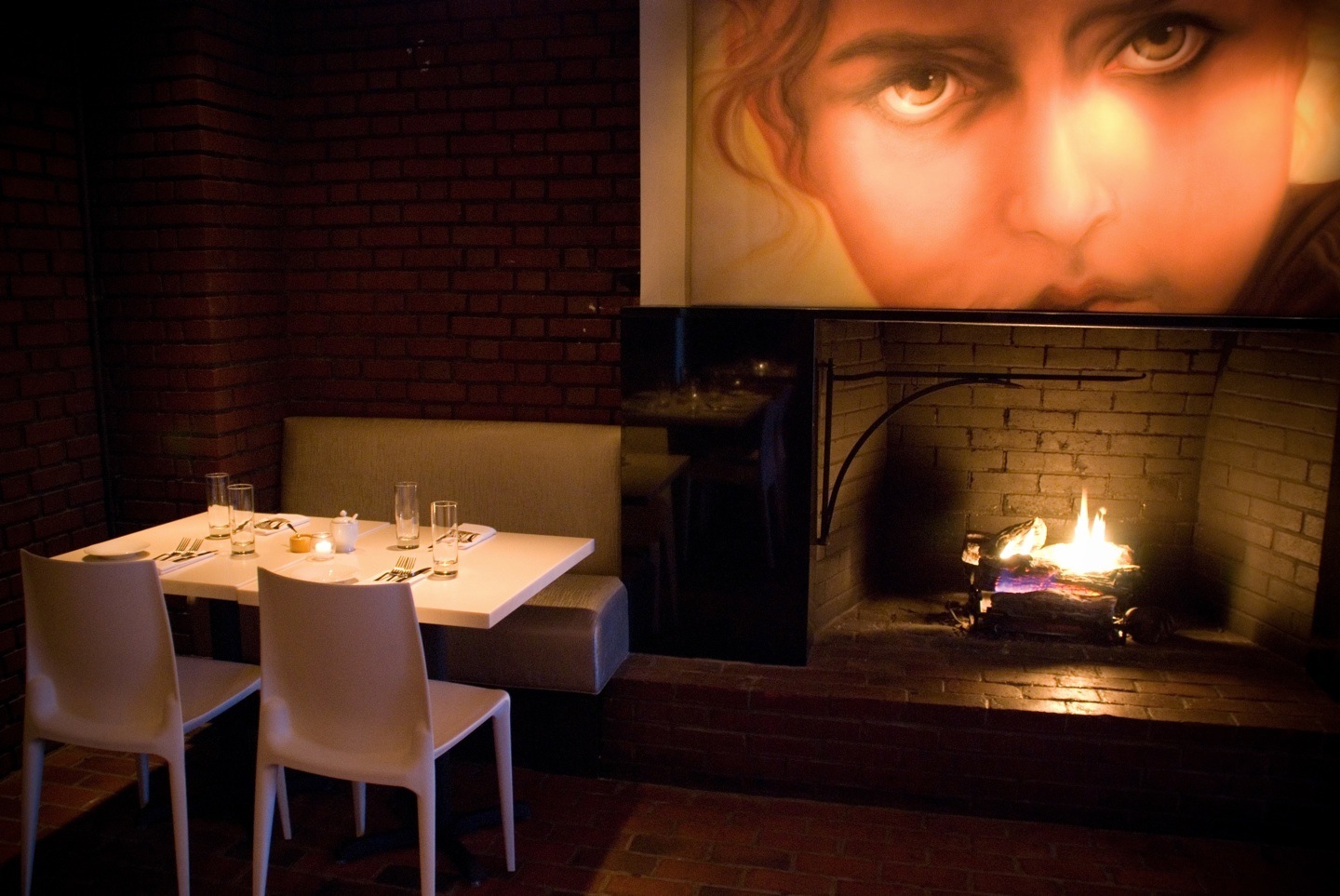 Chef/owner Zachary Bruell. (right)
Chef/owner Zachary Bruell. (right)LEMAIRE--The Jefferson Hotel, 101 West Franklin Street, Richmond; 804-649-4644; Chef Walter Bundy.
LOCANDA VERDE--379 Greenwich Street, NYC; 212-925-3797; Chef Andrew Carmellini/Owner.
MAREA--240 Central Park South, NYC; 212-582-5100; Chef /owner Michael White.
NOPALITO--306 Broderick Street, San Francisco; 415-437-0303; Chef/Owners Allyson and Laurence Jossel.
PACCI RISTORANTE--866 W Peachtree Street, Atlanta; 678- 412-2402; Chef Keira Moritz.
PACES 88--St. Régis Hotel, 88 West Paces Ferry Road, Atlanta; 404-563-7910; Chef Mark Alba.
PERLA’S SEAFOOD AND OYSTER BAR--1400 South Congress, Austin, TX; 512-291-7300; Chef.owner Lawrence McGuire.
PRADO--The InterContinental Montelucia Resort & Spa, 4949 E. Lincoln Dr. Scottsdale, AZ; 480-627-3200; Chef Claudio Urcuoli.
RIVERA--1050 South Flower Street, Los Angeles; 213-749-1460; Chef/owner John Sedlar.
SEASALT--1186 3rd Street, Naples, FL; 239-434-7258; Chef/owner Fabrizio Aielli.
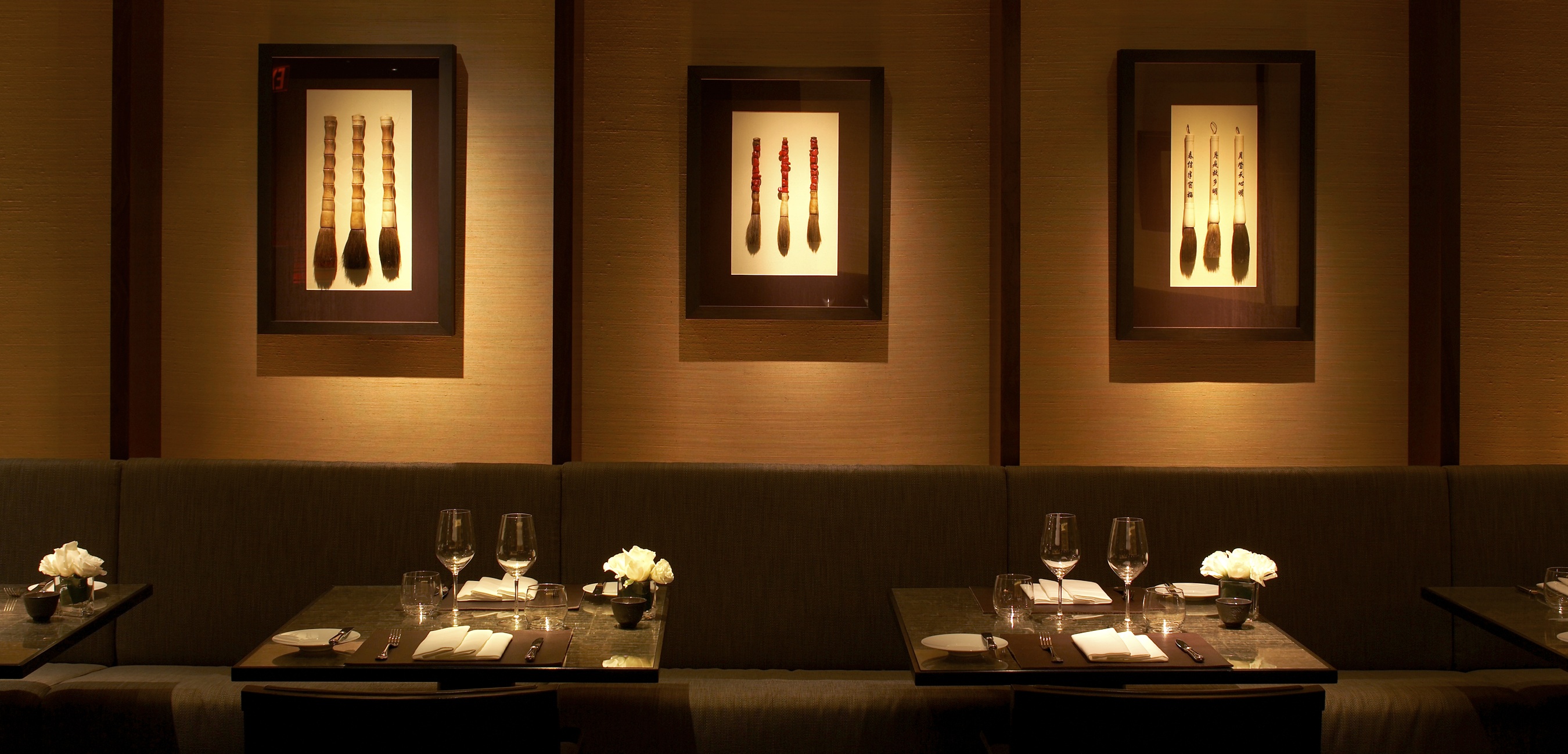
SHO SHAUN HERGATT--The Setai New York Hotel, 40 Broad Street; 212-809-3993; Chef Shawn Hergatt. (left)
SOCIETY CAFÉ ENCORE--Wynn Encore, 3131 Las Vegas Boulevard, Las Vegas; 702-248-DINE; Chef/owner Kim Cateenwalla.
SRA MARTINEZ--4000 NE 2nd Avenue, Miami; 305-573-5474; Chef/owner Michelle Bernstein.
~~~~~~~~~~~~~~~~~~~~~~~~~~~~~
ANOTHER
15 NEW RESTAURANTS YOU DON'T WANT TO MISS
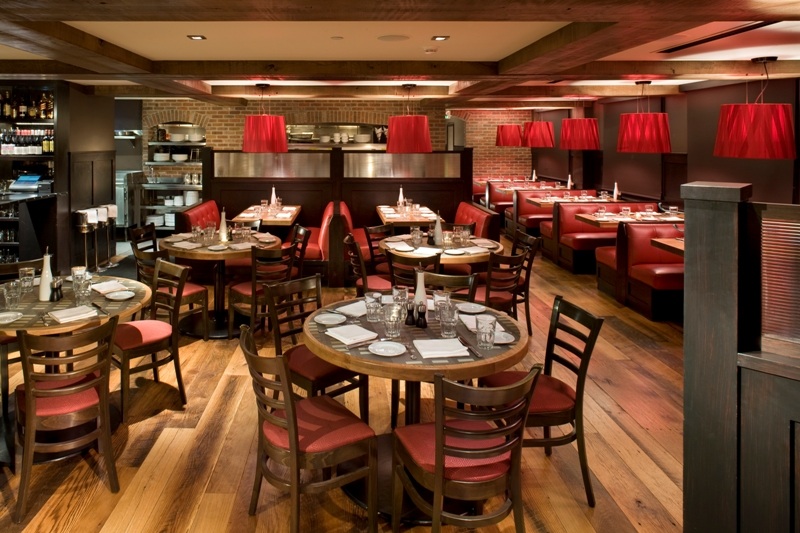
☛ AJAX TAVERN--Aspen,
CO (left)
☛ AUREOLE--NYC
☛ THE BRISTOL--Chicago
☛ 8100
MOUNTAINSIDE BAR AND GRILL--Avon, CO.
☛ IL
CASALE--Belmont, Massachusetts
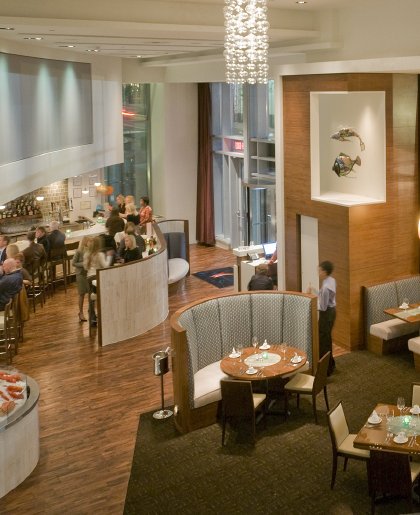
☛ PASSIONFISH--Reston, Virginia (left)
☛ PROVINCE--Chicago
☛ THE PUBLICAN--Chicago
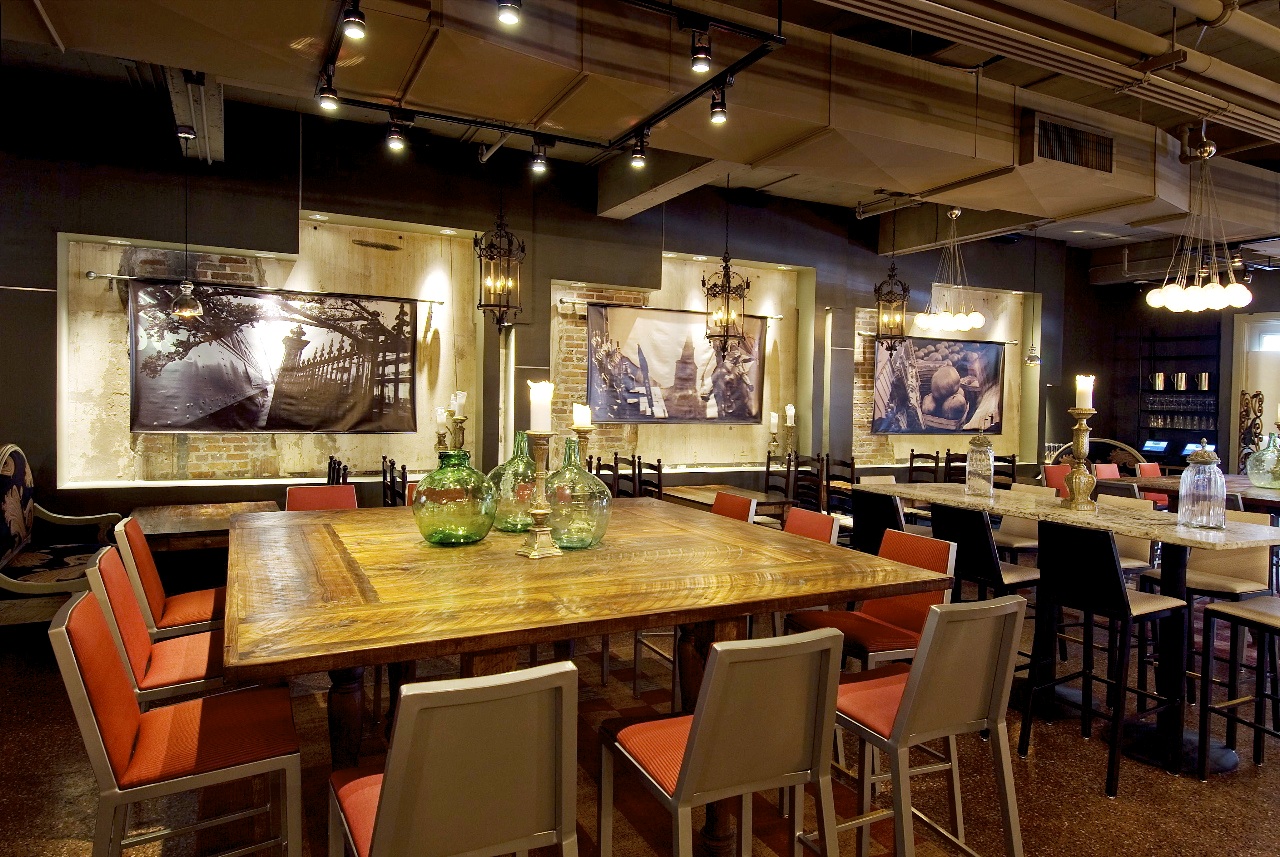
☛RAMBLA--New Orleans (left)
☛ RH--Los Angeles
☛ SEPIA--Chicago
☛ @VERMILION--NYC
☛
WEST
SIDE TAVERN, Los Angeles
. . . AND SOME WONDERFUL CHEFS TO KEEP YOUR EYE ON
✓Chris Lusk, Café Adelaide, New Orleans
✓David Katz, Meme, Philadelphia
✓Victoria Ann Moore, The Lazy Goat, Greenville, SC
✓Raymond Mohan, Onda, NYC
~~~~~~~~~~~~~~~~~~~~~~~~
NEW YORK CORNER
by John Mariani
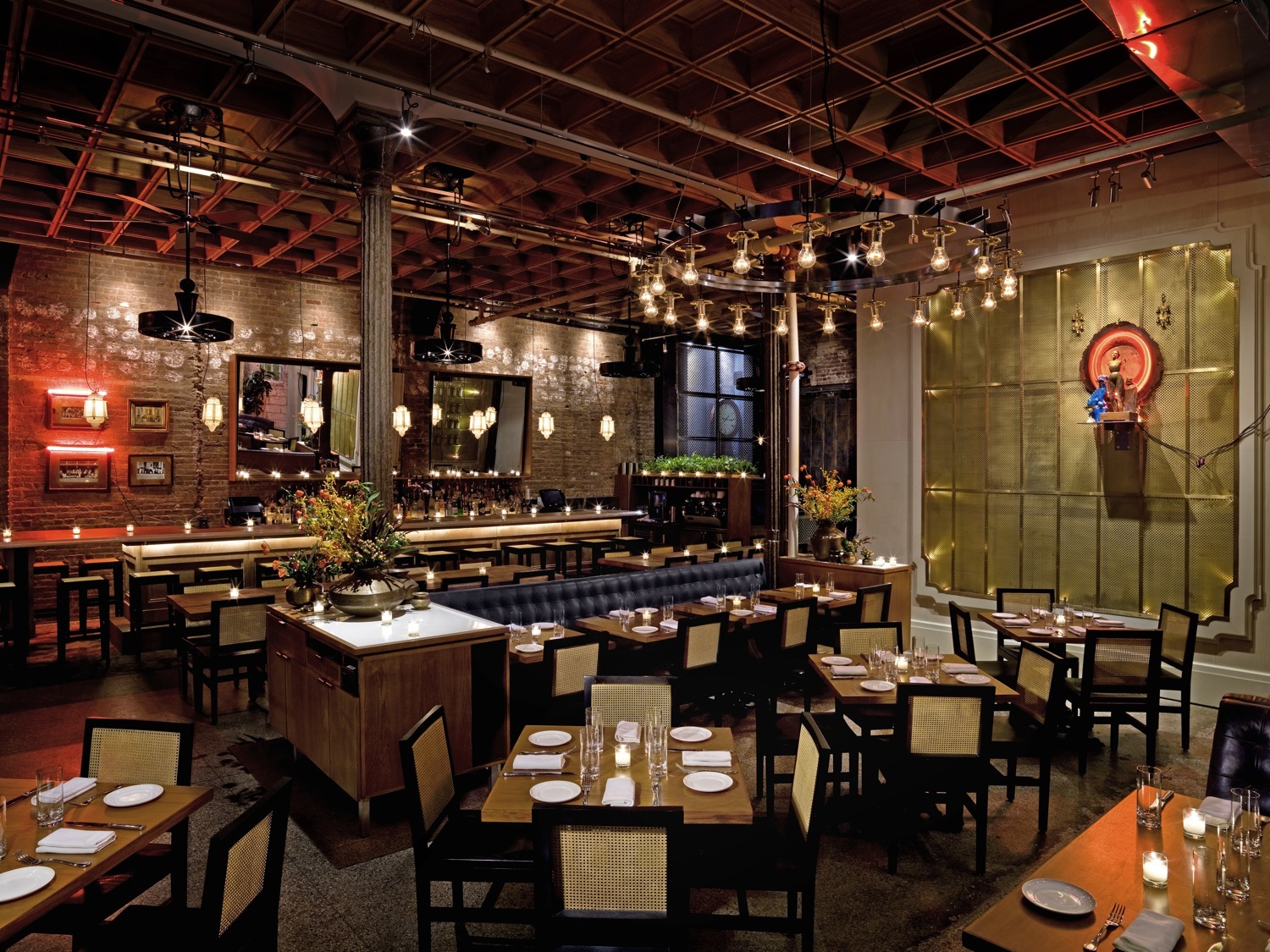
DOUBLE CROWN
316 Bowery (near
Bleecker Street)
212-254-0350
www.doublecrown-nyc.com
The
ever-growing restaurant scene on the Lower East Side and Bowery has
been one of ambitious aims for an area that depends largely on its
aim to be a hip place to go for food that would cost considerably more
uptown. Or at least that's how things began
down there. But anyone
checking out the menus at places like Allen & Delancey, Sorella,
Schiller's, Stanton Social, and wd-50 will find this really isn't the
case at all, when main courses can run to $35. And for the most part
you don't
get much in the way of décor or service, instead sittiing on
crappy
furniture, naked tables, waiters in sweaty t-shirts, and pulsing loud
music for your trip to the
neighborhood, plus, unless
you live down there, a whopping $20 taxi cab
fare both ways or parking lot bill.
Happily, Double Crown is not among the kind of
restaurants I just described on the Bowery. For starters, it's a very
good looking place and until the weather gets too cold, there are
outdoor tables that allow a delightful view 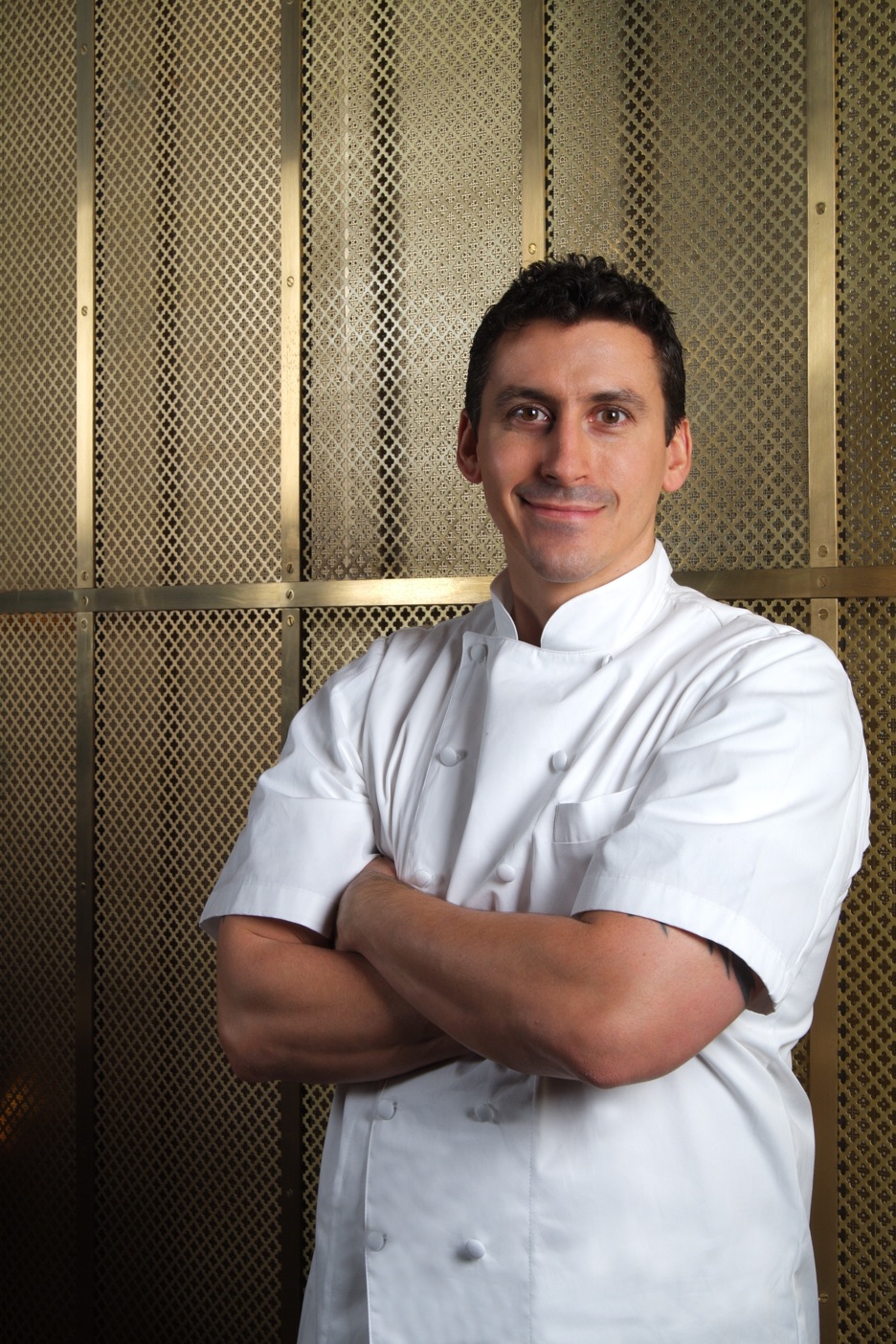 of the broad boulevard that is the Bowery,
which gets its name from Peter Stuyvesant's farm, in Dutch, bouwerji, once a very elegant
thoroughfare, later a Skid Row, now being changed by commerce into a
street of restaurants and shops. Secondly, there's nothing on the
menu above $29, and appetizers average about $13 (foie gras torchon
comes in at $18). And they offer a wide variety of very popular
snacks here from $4-$8.
of the broad boulevard that is the Bowery,
which gets its name from Peter Stuyvesant's farm, in Dutch, bouwerji, once a very elegant
thoroughfare, later a Skid Row, now being changed by commerce into a
street of restaurants and shops. Secondly, there's nothing on the
menu above $29, and appetizers average about $13 (foie gras torchon
comes in at $18). And they offer a wide variety of very popular
snacks here from $4-$8.
Owners Adam Farmerie, Kristina
O’Neal, William Harris, Greg Bradshaw, and Dan Rafalin were behind the
restaurant PUBLIC, opened in 2003, and Double Crown gets its moniker
from serving food from the “in-betweenness” of two disparate
cultures--19th century British and of those Asian territories it once
colonized, or tried to dominate. (There is also a separate hidden
bar and lounge named Madam Geneva, where I did not dine, but it's dark
and noisy, offering Double Crown's snacks.)
Executive Chef Brad Farmerie (right) and Chef de Cuisine
Christopher Rendell, a native of Melbourne, are doing some convincing
work of Anglo-Asian fusion; what's more, most of it is outright
delicious, starting with snacks like a "pint of prawns with Mary Rose
sauce" 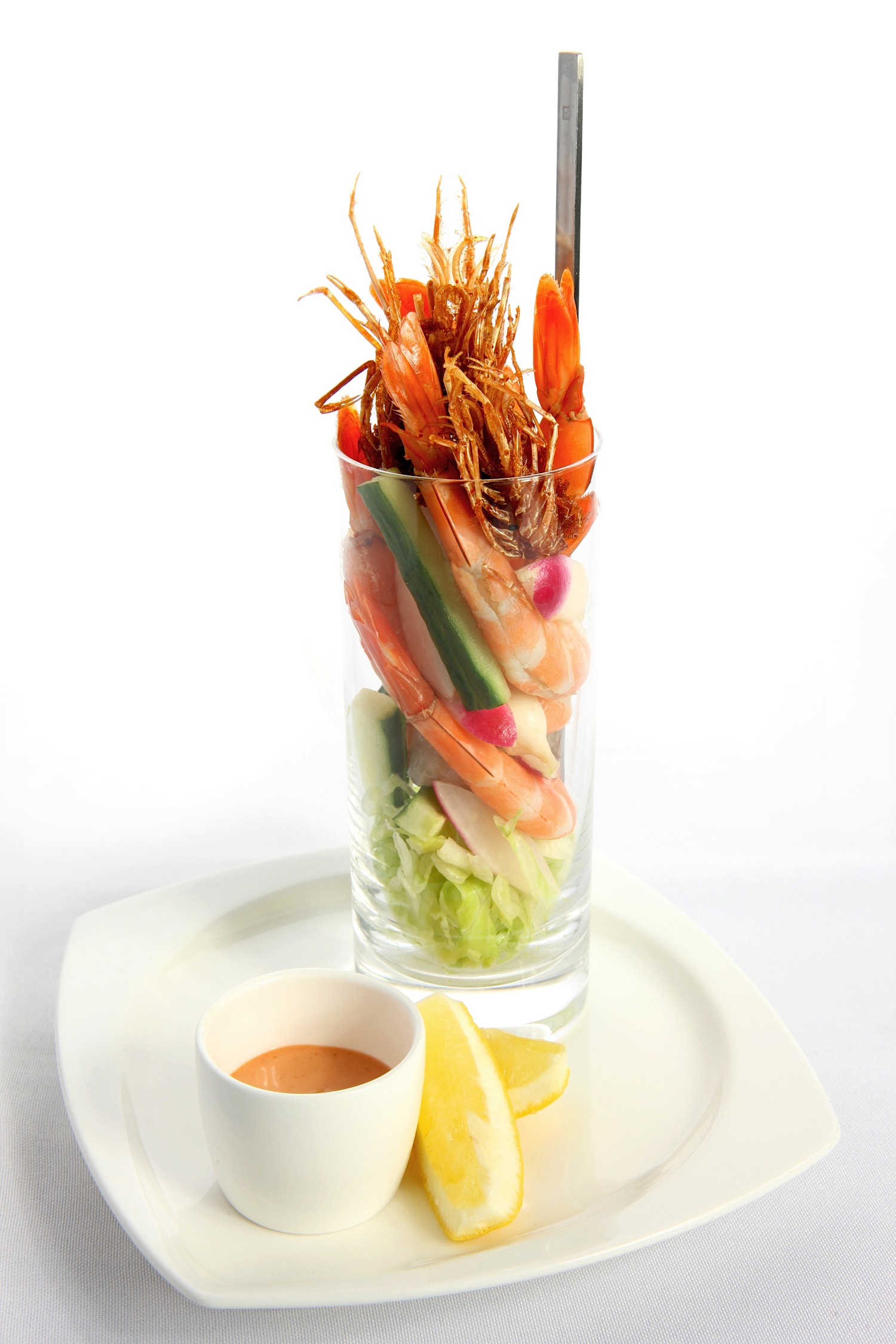 (below)
and Iceberg lettuce for crunch--they go down easily and quickly.
Also terrific are the spicy pork stuffed lychees with coconut sauce and
the Singapore laksa of rice
noodles, crab, and bean
sprouts. House-cured ham comes with black Mission figs and
a spicy grain mustard, and that foie gras torchon is worthy of it price
tag.
(below)
and Iceberg lettuce for crunch--they go down easily and quickly.
Also terrific are the spicy pork stuffed lychees with coconut sauce and
the Singapore laksa of rice
noodles, crab, and bean
sprouts. House-cured ham comes with black Mission figs and
a spicy grain mustard, and that foie gras torchon is worthy of it price
tag.
Indeed, I'd be very happy with just
ordering a mess of snacks and starters, but then I would have missed
the
braised pork belly with red lentil puree, snow pea shoots, and an
aromatic
star anise broth. The New York strip steak doesn't have anything
to do with Anglo-Asian reveries, but it's a fine rendering, as is the
steamed snapper with prawn dumplings, sesame broth and bok choy.
There are also some delectable side dishes of garam masala- dazzled
potatoes with the wonderful addition of baby spinach, and daikon fries
with a hot sambal mayo.
It's a stretch to characterize the
Double Crown
concept to desserts, but I don't much care as long as they are as good
as the
toffee corn panna with milk
ice cream or the blueberry rum cake
with brown sugar crumble, peach yuzu
sherbet and verbena ice cream.
Wine Director Rubén Sanz Ramiro likes an
eclectic range of bottlings from small producers, offering a 100-label
list with very fair prices across the board.
So if you're downtown and need a good
place to eat at a very reasonable price, Double Crown is the first
place I'd recommend, and happily so.
Double Crown is open
for brunch on Sat. & Sun, nightly for dinner.
~~~~~~~~~~~~~~~~~~~~~~~~~~~~~
THE END OF Gourmet
. . .
and so goes an era of fine food journalism
by John Mariani
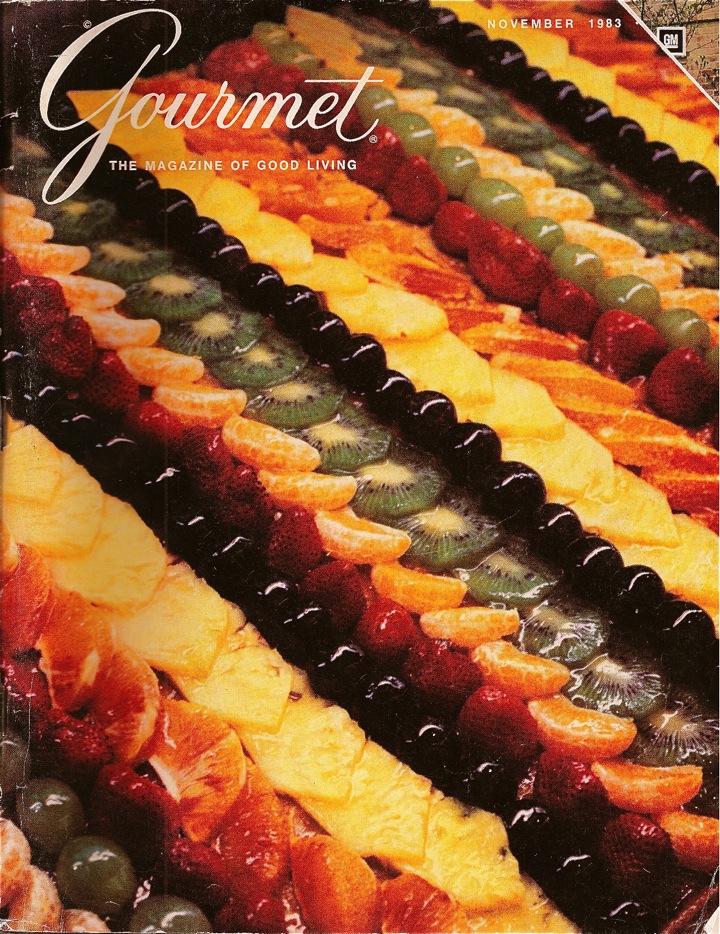 The
news gets worse and worse.
The
news gets worse and worse.
Publishers suffer withering decreases in circulation and ads,
they give most of their contents away free on the internet, and so many
close--Southern Accents, Vibe,
Portfolio, Best Life, Travel & Leisure Golf, Town & Country
Travel, Domino, Country Home, O at Home, CosmoGirl, Home, and
now Gourmet. After an
independent review of Condé Nast's Magazine division, rumor had
it that one of the company's food mags would be dropped, but most
thought it would be Bon Appetit,
if only because Gourmet was
considered a more prestigious title, dating back to January 1941.
Gourmet
Magazine cover, November 1983
It was a curious choice of title
back then, when the very word "gourmet" sent home cooks scurrying for
the nearest casserole dish. This was twenty years before Julia Child
encouraged Americans to master the art of French cooking, and in 1941 Gourmet's only real competition was
the Boston Cooking School Magazine, American
Cookery. Yet neither war rationing nor Americans' antagonism for
French culinary pretension could stop the new magazine from publishing
straight through the war. "Between Pearl Harbor and V-J Day, deluxe
existence became, along with taxicabs, T-bone steaks, whitewall tires,
and desirable travel accommodations, in great requisition, but never
entirely disappeared," wrote the great gourmand Lucius Beebe in
December 1945. "The torch which set the cherries Jubilee in flames was
never wholly extinguished."
From that time, until Condé Nast bought
the magazine in 1983, Gourmet was
owned by a fellow named Earle R. MacAusland, a 50-year-old veteran of
magazine-publishing veteran. In the first issue he declared that the
word "gourmet" was "a synonym for the honest seeker of the summum bonum of living," and the
contents of early issues were far more general interest than devoted to
cooking,
including everything from poetry and cartoons to theater reviews and
quizzes.
As the magazine grew in
circulation and focus, MacAusland never seemed to give a care in the
world to prevailing trends, and the magazine thrived on a heavy dose of
Francophilia, including a low-priced cooking section called "Gastronomie Sans Argent." The
closest thing Gourmet got to
acknowledging changes in the culinary world was a section called "Cuisine Courante." The
magazine did cover the world, though rarely Asia, and sent its
writers everywhere, as they did the ubiquitous Ronny Jacques, a
photographer who seemed to snap every picture in the book, sometimes
with coverage within a single issue of Normandy, Norway, Newport,
and New York. Of course, since Gourmet's
coverage was timeless, the
articles and photos might have been researched two years before they
actually got into the magazine.
Gourmet's
thickening success certainly
coincided with the gourmet revolution wrought by Julia Child and other
TV cooking stars like Graham Kerr, "The Galloping Gourmet," and it
had long attracted illustrious authors, among them Beebe, Leslie
Charteris
(author of "The Saint" mysteries), George Jean Nathan, A.J. Liebling,
Joseph Wechsberg, M.F.K. FIsher, Richard Condon, and a slew of women
who, as Nora Ephron quipped, all
seemed to have three names, like Lillian Langseth-Christensen, Anne
Marshall Zwack, and Polly
Woollcott Murphy.
There was, however, much that was fey about
the
writing, with plenty of woozy descriptions of bars and bartenders and
outdated words like "methinks," "bijouterie," and "splendiferous."
Restaurant coverage was not limited to New York and California, but
every issue had columns on those two locations, and they went on and on
for pages. There never seemed to be a pâté maison or coquilles Saint-Jacques that a Gourmet reviewer didn't love.
When Condé Nast took over, changes
came slowly, editors and writers were let go, and the coverage became
far more international, though with increased emphasis on American
food, high and low, the latter chronicled by the redoubtable road food
experts Jane and
Michael Stern. The arrival of Ruth Reichl, after her five-year
stint as restaurant critic of the New
York Times, blew a great deal of welcome, fresh air into the
title, 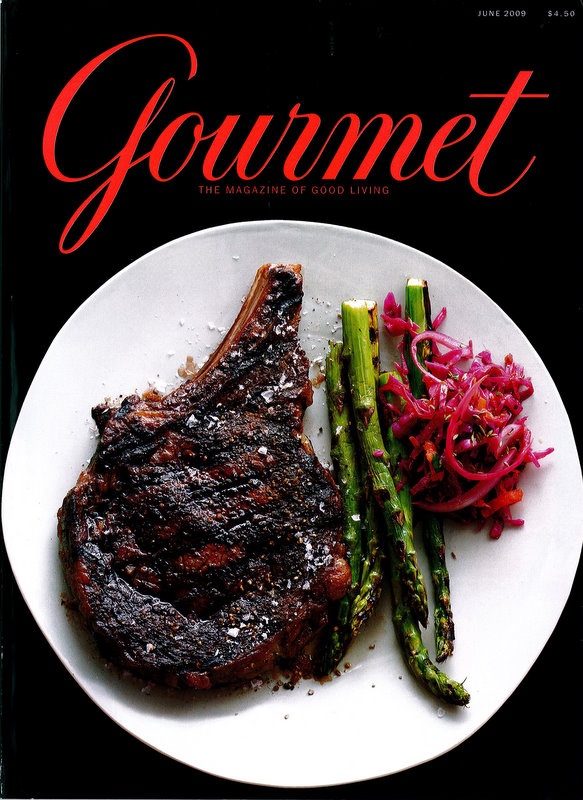 and new, younger writers--including many who
wouldn't know pâté
maison from pâte
brisée--were encouraged to exult in the wonders of home
cooking in Myanmar along with in-depth discussions of animal
husbandry, sustainable food, along with the various culinary trends
that wafted through
the last two decades.
and new, younger writers--including many who
wouldn't know pâté
maison from pâte
brisée--were encouraged to exult in the wonders of home
cooking in Myanmar along with in-depth discussions of animal
husbandry, sustainable food, along with the various culinary trends
that wafted through
the last two decades.
In recent years there also seemed a deliberate
attempt to stir things up, as when Alinea, a controversial molecular
cuisine in Chicago open for less than six months, was declared the
single greatest restaurant in America and David Chang the most
important chef of the last fifty years. Apparently that sort of
thing didn't help, and ever since the recession of 2008 took hold, Gourmet covers were less about molecular
cuisine and durian fruit than about hamburgers,
ribeyes, and barbecue.
The ads dropped away,
as they did for Gourmet's
sister publication, Bon Appetit,
and Condé Nast made cuts across the board in staff and
expenses--before which the idea of sending a writer and photog off for
weeks on a story was business as usual. According to
Publishers Information Bureau, Gourmet had a 46.9% drop in ad
revenue and a 50% decline in ad
pages in the second quarter from last year's April-June period; Bon Appetit's revenue
fell 36% and ad pages by 40%, In the end, Gourmet was hemorrhaging money and
its circulation was well under Bon
Appetit's 1.3 million readers.
Gourmet June 2009
When closure came it came with surgical precision:
staffers, including Reichl, were told to leave the building within 48
hours.
It is sad when any magazine goes
under and chilling when a longtime institution like Saturday Evening Post, Collier's, Look,
Life, and so many others fade away. At a time when so much
food journalism has turned into hyperventilated contrivance and
vulgarity, the loss of a first-rate, first-class magazine like Gourmet will leave a very big hole
in the affections and the cooking ambitions of Americans, some of whom
might never have cooked a single recipe from the magazine but whose
stockpiled copies in the attic still have hundreds of paper strips
stuck within the pages because Gourmet
made a dish both look and sound so irresistibly good.
. . . WHICH BRINGS UP ANOTHER QUESTION? WHAT IS THE DIFFERENCE BETWEEN A RESTAURANT CRITIC AND A FOOD WRITER?
The demise of Gourmet, which once hired some of the world's finest food writers, some of whom enjoyed the largess of Condé Nast budgets and others who did not, brings up the question, what is the difference between a local newspaper "restaurant critic" and a "food writer"--one brought into focus this week by the respected restaurant critic Tom Sietsema of The Washington Post, when he wrote, "I tend to trust newspaper reviewers to magazine critics, some of who are too easily seduced by public relations people."
Since I've known Tom as a friend and colleague for nearly 20 years, I take what he says seriously, so I spoke with him on the phone about his contention. He reiterated that while he has tremendous respect for many of the nation's food writers in magazines like Gourmet, Bon Appetit, Saveur, and others, he believes that
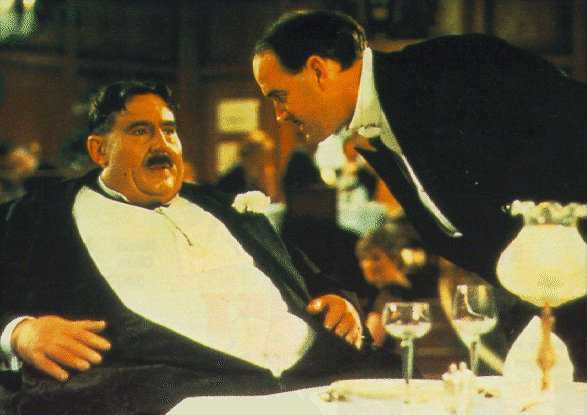 a
local newspaper's restaurant critic, as well as those writing for city
magazines like Washingtonian,
is more reliable because he usually visits a restaurant two or three
times before reviewing and goes anonymously, even, in Tom's case, in
disguise. "I don't think a chef can necessarily become a better cook
when he spots a restaurant critic," he told me, "but he might be able
to select the best piece of fish in the kitchen or not serve one left
from last night. Even though I am often recognized, I think the element
of surprise is important."
a
local newspaper's restaurant critic, as well as those writing for city
magazines like Washingtonian,
is more reliable because he usually visits a restaurant two or three
times before reviewing and goes anonymously, even, in Tom's case, in
disguise. "I don't think a chef can necessarily become a better cook
when he spots a restaurant critic," he told me, "but he might be able
to select the best piece of fish in the kitchen or not serve one left
from last night. Even though I am often recognized, I think the element
of surprise is important."Still, Tom admits that a food writer who sits down with a chef to interview him or her, asks to be guided in the choice of dishes and wines, and perhaps obtain a recipe is valuable, too. "You can get really good stories out of the interaction with chefs and restaurateurs, but readers need to read it that way, not as a restaurant review, and I don't think readers are that careful these days." Nor do I.
I also think that if a local restaurant critic has the unfettered budget of those very few newspapers, like The Washington Post, The San Francisco Chronicle, and NY Times, that don't blink at his expense account, the reader will get a more complete indication of an individual restaurant's strengths and weaknesses. National magazine food writers don't have the time or budget to visit more than once--including, as Tom told me, himself, when he travels outside of DC, saying he pays about $15,000 to $20,000 a year out his own pocket to travel because the Post does not send him, and, when on such excursions, he can only visit a place for a single meal.
The important distinction here is that nowhere on the mastheads of the most renowned food or lifestyle magazines will you ever find anyone called "restaurant critic." You may see "contributing writer," "reporter at large," "food writer, or, in my case at Esquire, "food & travel correspondent." It would be almost unheard of for a magazine to, say, fly a writer to Munich or Paris or Tangiers for a week and tell him to eat anonymously at least three times at a single restaurant for an article intended as a round-up of good places to eat in those cities. The writer might go to 10 or more restaurants, once, then whittle those down to a half dozen to make the magazine's length limit. Far more often than not, these writers want diligently speak with the owner and chef as to what kind of cuisine the restaurant serves, what is special about his cassoulet
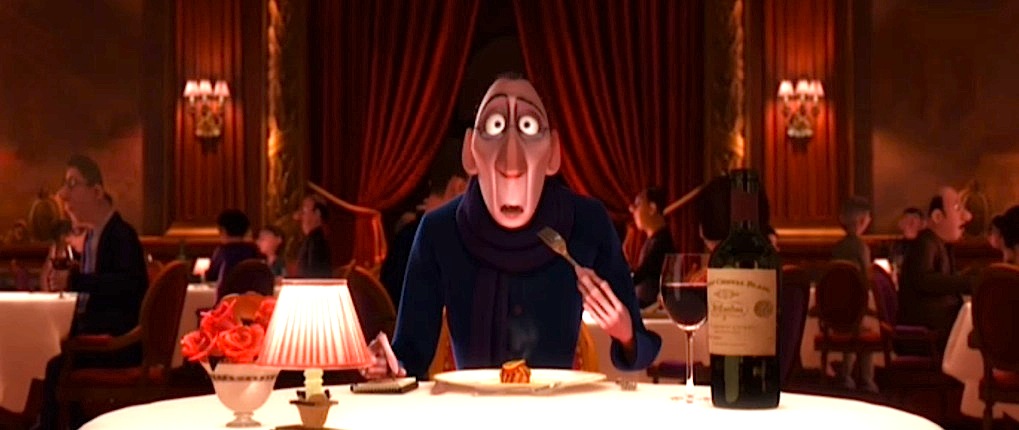 or
couscous, and to learn as much as possible about the food culture in a
short period of time. In the case of the Michelin Guide inspectors (notice
they are not called
"restaurant critics"), they go to a restaurant once, usually alone, and
on that slim evidence either do their write-up or, if a restaurant
looks like it might merit a star, recommend follow-up visits by a
totally different inspector.
or
couscous, and to learn as much as possible about the food culture in a
short period of time. In the case of the Michelin Guide inspectors (notice
they are not called
"restaurant critics"), they go to a restaurant once, usually alone, and
on that slim evidence either do their write-up or, if a restaurant
looks like it might merit a star, recommend follow-up visits by a
totally different inspector.Also, newspaper and local critics--much to their dislike--have to give out those odious stars, for people who don't bother to read the review; national magazine writers never do.
Many of the greatest food and travel writers, including Johnny Apple of the New York Times, Waverly Root of the Washington Post, James Villas of Town & Country, Colman Andrews of Gourmet, and A.J. Liebling and Calvin Trillin of The New Yorker would never answer to the title "restaurant critic," and most of their best writing was done after extensive meals with the chef or owner of the restaurant under consideration, trying to put it into perspective with the local food culture. Unlike most local restaurant critics, whose papers will not fund trips ourside the region, food writers travel and get to know what's going on everywhere from Bangkok to Bangor, Bordeaux to Boston.
There is a very important, if not razor-sharp, distinction between restaurant critics and food writers, and both play their parts in food culture. Sadly, losing Gourmet is another blow against good writing at a time when blogs by anonymous, unedited "eaters" clog up the internet. No responsible newspaper would ever allow the kind of foul-mouthed drivel and libels that fills blogs to be published in its Letters to the Editor section, but they allow it in their blogs. As Christopher Kimbal, publisher of Cook's illustrated, wrote in an op-ed in the NY Times last week, "The shuttering of Gourmet reminds us that in a click-or-die advertising marketplace, one ruled by a million instant pundits, where an anonymous Twitter comment might be seen to pack more resonance and useful content than an article that reflects a lifetime of experience, experts are not created from the top down but from the bottom up. They can no longer be coronated; their voices have to be deemed essential to the lives of their customers. That leaves, I think, little room for the thoughtful, considered editorial with which Gourmet delighted its readers for almost seven decades."
~~~~~~~~~~~~~~~~~~~~~~~~~~~
NOTES
FROM THE WINE CELLAR
Champagne in
All Its Fizzy Varieties, Part One
by Brian Freedman
 Despite the worldwide
popularity of its wines and the supremely evocative nature of the name
itself, the Champagne region remains one of the most misunderstood in
all of France. This, indeed, is one of the great paradoxes of the wine
world: That perhaps its single most instantly recognizable wine
remains, in many ways, a cipher, a victim, in some regards, of the very
qualities that have made it so beloved. Indeed, too many consumers
still don’t delve into the intricacies of Champagne beyond the house
they like most.
Despite the worldwide
popularity of its wines and the supremely evocative nature of the name
itself, the Champagne region remains one of the most misunderstood in
all of France. This, indeed, is one of the great paradoxes of the wine
world: That perhaps its single most instantly recognizable wine
remains, in many ways, a cipher, a victim, in some regards, of the very
qualities that have made it so beloved. Indeed, too many consumers
still don’t delve into the intricacies of Champagne beyond the house
they like most.
Which is why Champagne producers,
growers, and marketing professionals are working overtime to educate a
mostly un- (or, even worse, mis-) informed public about not just what
constitutes Champagne but also about the geography and stylistic
divisions within the region itself.
Fortunately, the CIVC (the Comité
Interprofessionnel
du Vin de Champagne) is fighting the good fight, working
tirelessly to
educate both wine professionals and casual consumers alike. In
September, I was fortunate enough to attend a fantastic program in
Champagne, sponsored by the CIVC, that aimed to clarify lingering
confusions, provide the kind of education that only a shoes-in-the-soil
experience can, and offer a sense of context for the wines during the
harvest season.
Over the course of four solid days
of visits, discussions,
tastings, and meals, one thing stood out above all else: Champagne is a
far more diverse region, with a greater range of terroirs, styles, and
grape-growing and winemaking philosophies, than it is typically given
credit for. After spending a bit of time there, it has become more
apparent than ever that a detailed look at the region itself—through
the wines that exemplify the differences within it—is necessary.
The dominant style in Champagne is the
non-vintage house blend. From Veuve Clicquot to Piper-Heidsieck to
Krug, non-vintage cuvées
receive the lion’s share of fame and
familiarity. This reliance on an NV house style is an insurance policy
of sorts in a region where, traditionally, the cooler climate has made
grape ripening and vintage consistency a struggle, or, at the very
least, something that just could not be guaranteed with an acceptable
sense of regularity. The house style, then, provides a measure of
predictability for consumers.
But while most consumers tend to
think of Champagne as divided and defined primarily by the grands maisons and their
non-vintage bottlings (though, of course, certain têtes de
cuvée have carved out their own special niche in the wider
public consciousness), the region is, in fact, home to several distinct
sub-regions, each of which has its own unique character.
The Montagne de Reims, which runs between
and beyond Reims and Épernay, is home to the quintessentially
chalky
soils of the region, as well as good bit of pinot noir, which provides
structure and complexity to the wines, as well as notes of berry fruit
and, when expressing itself fully, earthier notes.
Extending west from Épernay is the
Vallée de la Marne, which benefits from chalky soils as well, in
addition 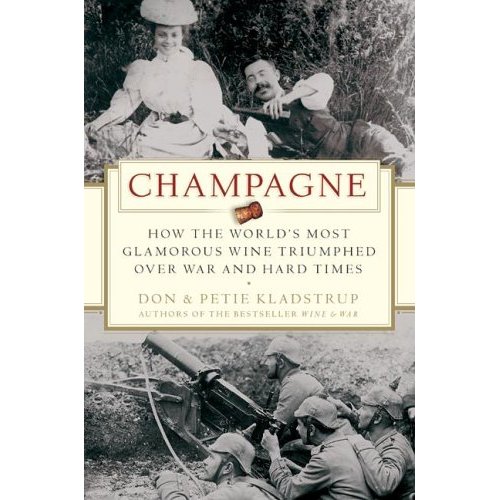 to more
surface-level clay and sand and a number of south-facing slopes. pinot
meunier thrives here—its resistance to frost is a real asset.
to more
surface-level clay and sand and a number of south-facing slopes. pinot
meunier thrives here—its resistance to frost is a real asset.
The Côte des Blancs is a more or
less north-south extension that reaches to Vertus from Chouilly,
southeast of Épernay. As the name suggests, this is chardonnay
country.
And, in fact, it is here that Champagne’s most famous chardonnay is
grown: Street signs pointing the way to Cramant, Avize, and—holy ground
for blancs de blancs fans—Le-Mesnil-sur-Oger dot the landscape.
Finally, well south is the Côte des
Bars. The parts we visited, including the lovely Avirey-Lingey, looked
like nothing so much as the ancestral heart of France, the scenery and
towns evocative and charmingly storybook-like. Historically,
the Côte des Bars has had to fight its way toward acceptance in
Champagne. (There is an excellent, entertaining account of this in the
book Champagne: How the World’s Most Glamorous
Wine Triumphed Over War and Hard Times by Don and Petie
Kladstrup.) But these days, with excellent pinot noir and standout
wines like those of Serge Matthieu, its status seems assured. The
terroir here is stonier and much more similar to nearby Chablis than to
its more northern Champagne siblings, but the quality is certainly
there, and the wines are often idiosyncratic, surprising, and finely
wrought.
Next Week: Part Two and
Some Favorites
☛ Brian Freedman is a food
and wine writer, wine educator, and food and wine consultant. He is
Director of Wine Education for the Wine School of Philadelphia,
contributing editor for Philadelphia
Style Magazine, wine columnist for
Affluent Magazine, and
writes the blog www.UncorkLife.com for
www.WineChateau.com. His web site is www.BrianFreedmanPhiladelphia.com.
~~~~~~~~~~~~~~~~~~~~~~~~~~~~~~~~~~~~
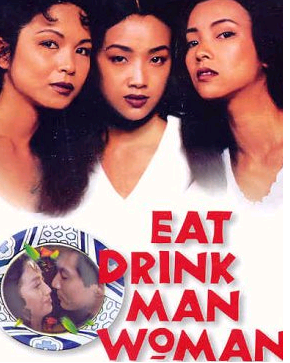
☀
In Japan Chef
Hitoshi Ueda of the restaurant named Long Pig
is using "human
fat from liposuction clinics to make simple dishes, like fried rice.
Then I might add a few small pieces of meat, like the kind that might
come from a nose job or a finger amputation. That costs about 100,000
yen. If I can get a
large piece, like a whole leg, I might cure it to make ham or grill it
to make a steak. That might cost as much as much as a million yen.” When
asked about how human flesh tastes, he said, “It varies from
person to person.” The Japanese Ministry of Food
Purity and Safety
told the press, “The meat is closely regulated and inspected. No
diseased meat is
used. Inspectors also insure that all the pieces of meat come from
medically necessary surgeries. No one is allowed to just cut off an arm
or leg and sell it for profit. We also don’t allow imports or the use
of meat from dead people. We must be certain that no tainted meat is
served.”
WHEN THE New York Times IS WRONG, THEY SAY SO!
“CORRECTION: A brief review last Wednesday
about the Brooklyn
Star restaurant . . .referred incorrectly to the restaurant’s wall
paneling. It’s a combination of custom-made and stock paneling, not
just stock.”—NY Times, Sept.
23, 2009.
~~~~~~~~~~~~~
* Guidelines
for submissions: QUICK
BYTES publishes
only events, special dinners, etc, open to the public, not restaurant
openings or personnel changes. When submitting please send the
most pertinent info, incl. tel # and site, in one short paragraph as
simple e-mail text, WITH DATE LISTED FIRST, as below.
Thanks. John Mariani
* In October in Chicago, IL, The Peninsula Chicago has created a number of initiatives during October to raise awareness and funds Lynn Sage Cancer Research Foundation, incl. : the front entrance and hotel name will be back lit with pink lighting to build awareness for women to remember to schedule their annual mammogram, $2 for every Afternoon Tea and Chocolate Bar served in The Lobby will be donated to the Lynn Sage Cancer Research Foundation along with $5 in Avenues and Shanghai Terrace when mentioning Lynn Sage Cancer Research Foundation. Spa guests will be able to make a donation on their bill when leaving The Spa.
* From now thru Oct. 25 in NYC, Brick Lane Curry House celebrates the Indian holiday of Diwali with a series of rotating menus representing the cuisines of the four corners of India. Female diners will receive a free goodie bag of Indian sweets over the holiday weekend of Oct. 16th-17th. Call 212-979-2900. www.bricklanecurryhouse.com.
* Starting Oct. 12 in NYC, La Fonda del Sol will offer a Spanish 3-course prix fixe menu at lunchtime. The "Cocina Rapida" menu is designed for a 40-minute lunch break, and incl. a choice of 3 appetizers, 3 entrées and a dessert "to go." $35 pp. Call 212-867-6767 or visit www.patinagroup.com.
* On
Oct.14, 21, 28, in NYC, Thalassa, in Tribeca, Executive Chef
Ralpheal Abrahante will teach fall cooking classes in the restaurant's
open kitchen. $75 pp. . . . On Nov. 16, Thalassa
presents a Greek Wine and Cheese Tasting Class in the Wine Room, with
10 Greek cheeses and 10 Greek wines, with special guests Chris
Hallowell from Wine & Spirits
Magazine, and Thalassa Maitre D' Niko Mavreas. $65 pp. Call
212-941-7661.
* On Oct.
15 Giorgio Ristorante inside
Mandalay Place, Las Vegas,
in partnership with Whole Foods Market and Indian Wells Brewing Co.,
will be hosting a beer pairing dinner. Chef Nico Chessa’s menu
matched 3 courses of Italian food with 3 Indian Wells microbrews.
$49 pp and each guest will leave with a gift card to Whole Foods
Market. Call 702-920-2700 or email info@langdonflynn.com.
* On Oct.
15 in Yountville, CA, Brix restaurant will host the last
of 3 “street food” dinner events called “Brix Unpaved.” beginning with
an Italian-themed evening called “Street Feasts of Sicily.” $35
pp at www.brix.com Call 707-944-2749.
* On Oct.
17 Chillingsworth in Brewster, MA, will host its
annual game dinner featuring wild game, wild local shellfish & line
caught fish, local mushrooms, seabeans and herbs. The wines featured
will be a selection of white from Remy Pannier of the Loire Valley.
$125 pp. Call 508-896-3640.
* On Oct.
17, Chef Robert Danhi author
of James Beard nominated book, Southeast
Asian Flavors: Adventures in cooking the food of Thailand, Vietnam,
Malaysia and Singapore will be conducting a culinary tour
through Little Saigon in Westminster,
CA, and will incl. food, beverage and a signed copy of
Southeast Asian Flavors for $75. Call 310-648-7970 to get
complete details.
* On Oct. 18 at Le Titi De Paris in Arlington Hts., IL, Chef Michael Maddox will holds the 2nd Local Cuisines Wine Dinner at $48 pp. ingredients locally and sustainably. Call 847-506-0222.
* On Oct.
21 in NYC, Bar Boulud will hold a Domaine Saint
Prefert Wine Dinner with Isabel Ferando, five courses paired with
wines. $150 pp. Call 212-595-0303; www.danielnyc.com.
* From
Oct. 21-24 The Chew Chew
Restaurant in Riverside,
ILL, will host a 5-course Autumn Wine Dinner $60 per
person plus tax and gratuity. Reservations are encouraged by calling
708-447-8781.
* From
Oct. 22-25, the village of Kohler,
WI, presents the 2009 Food
& Wine Experience.
With tips and treats from culinary experts including Jacques
Pépin, Andrew Zimmern and Lidia Bastianich, Kohler’s Food &
Details are available at www.KohlerFoodandWine.net or 1-800-344-2838.
* On
Oct.23 in Temecula, CA,
Boornman Vineyards Estate Winery of Murrieta & Temet Grill at
the Temecula Creek Inn present
a 4-course "An Artisan Wine Dinner Experience" with winemaker
Todd Boorman and cuisine by Executive Chef Salvatore
Giuliano. $85 pp. Call er person for the four-course menu,
exclusive of tax and gratuity. Temet Grill Call 951-587-1465.
* On
October 23 and 24 in Washington,
DC at the Hilton Washington, The National Italian American
Foundation presents Piazza d' Italia,
showcasing the best of Italian food, wine, fashion and culture. Sample
Italian wines, olive oils, chocolates, gelato and pasta. Also items
from the
Abruzzo region and the city of L'Aquila, which was devastated by an
earthquake earlier this year. It's free and open to the public.
Call 202387-0600 or e-mail piazza@niaf.org.
* On Oct. 23 in South
Salem, NY, Le Château will
hold a
6-course Louis Latour Wine Tasting Dinner. $95 pp. Call
914-533-6631.
* Beginning Oct. 25 thru Oct. 31 in NYC, Beppe will present their Menu della Strega to celebrate
Halloween. The $60 menu features dishes such as foie gras with an
apple jolly rancher reduction and baked apple, and rock shrimp tossed
with black spaghetti in a pumpkin and squash puree. Call 212-
982-8422 or visit www.beppenyc.com.
* On Oct. 27 in Brooklyn, NY, the Brooklyn
Chamber of Commerce
will present the 12th Annual Brooklyn
Eats, a cultural food tasting
extravaganza showcasing over 30 Brooklyn restaurants, lounges and
cultural institutions at Abigail Kirsch -Stage 6 at Steiner Studios.
Proceeds go to the Brooklyn Eats Scholarship Fund. $110 pp.
$125 at-the-door; visit www.ibrooklyn.com.
* On Oct. 28 in Old
Town Alexandria, VA, lifestyle expert Jason Tesauro and Chef
Dennis Marron of The Grille at
Morrison House kick-off a 4-part men’s lifestyle series covering
food, wine and cocktails. The first in a series of 4 classes, is
“Sticks & Stones: Cigar How-tos and Whiskey Wherefores,” where
guests learn the difference between single malts and blends, while
appreciating the virtues of cigar cutting, rolling and smoking.
The series will continue Nov. 18 with “Brews and Birds: Craft Beers and
the Art of Carving,"; Dec. 16 “Corks & Forks: Essential
Wines and Splendid Pairings,” and Jan. 27 with "Fizz and Flask."
Call 703-838-8000.
* On Oct. 29 in San
Francisco, Fifth Floor
restaurant at the Palomar Hotel will host a“Mad Hatter” wine dinner in
celebration of the U.S. release of this 2006 Shiraz by Hewiston
Wines. The dinner feature a multi-course pairing menu from Chef
Jennie Lorenzo, complemented by whimsical Mad Hatter-themed
décor. $75 pp. Call 415-348-1111.
* On Oct. 29 in NYC,
Dirt Candy restaurant
celebrates its first anniversary with special prices-- all appetizers
on the menu will be $5.30 and all entrees will be $10.29.
Call 212-228-7732, or www.opentable.com.
* From Oct. 29-Nov. 8, six internationally
celebrated chefs, incl. Ulf Braunert of the Palace Luzern, will
be joining executive chef Stefano Di Salvo at Cornerstone restaurant and bar at
Park Hyatt Seoul for Park
Hyatt’s first Asia-based edition of its annual Masters of Food and Wine
Festival. Highlights incl. Asian cuisine cooking classes and an art
gallery dinner at The Gallery Park Ryu Sook. Email
caitlin@alicemarshall.com or call 212 861 4031.
Everett Potter's Travel Report:

~~~~~~~~~~~~~~~~~~~~~~~~~~~~~~~~~~~~~~~~~~~~~~~~~~~~~~~~~~~~~~~~~~~~~~~~~~
Eating Las Vegas is the new on-line site for Virtual Gourmet contributor John A. Curtas., who since 1995 has been commenting on the Las Vegas food scene and reviewing restaurants for Nevada Public Radio. He is also the restaurant critic for KLAS TV, Channel 8 in Las Vegas, and his past reviews can be accessed at KNPR.org. Click on the logo below to go directly to his site.
~~~~~~~~~~~~~~~~~~~~~~~~~~~~~~~~~~~~~~~~~~~~~~~~~~~~~~~~~~~~~~~~~~~~~~~~~~~
Tennis Resorts Online: A Critical Guide to the World's Best Tennis Resorts and Tennis Camps, published by ROGER COX, who has spent more than two decades writing about tennis travel, including a 17-year stretch for Tennis magazine. He has also written for Arthur Frommer's Budget Travel, New York Magazine, Travel & Leisure, Esquire, Money, USTA Magazine, Men's Journal, and The Robb Report. He has authored two books-The World's Best Tennis Vacations (Stephen Greene Press/Viking Penguin, 1990) and The Best Places to Stay in the Rockies (Houghton Mifflin, 1992 & 1994), and the Melbourne (Australia) chapter to the Wall Street Journal Business Guide to Cities of the Pacific Rim (Fodor's Travel Guides, 1991). THIS WEEK:

Family Travel
Forum: The
Family Travel Forum (FTF), whose motto is "Have Kids, Still Travel!",
is dedicated to the ideals, promotion and support of travel with
children. Founded by business professionals John Manton and Kyle
McCarthy with first class travel industry credentials and global family
travel experience, the independent, family-supported FTF will provide
its members with honest, unbiased information, informed advice and
practical tips; all designed to make traveling a rewarding, healthy,
safe, better value and hassle-free experience for adults and children
who journey together. Membership in FTF will lead you to new worlds of
adventure, fun and learning. Join the movement.
All You Need to Know Before You Go
nickonwine: An engaging, interactive wine column by Niclk Passmore, Artisanal Editor, Four Seasons Magazine; Wine Columnist, BusinessWeek.com; nick@nickonwine.com; www.nickonwine.com.

MARIANI'S VIRTUAL GOURMET NEWSLETTER is published weekly. Editor/Publisher: John Mariani.
Contributing Writers: Robert Mariani,
John A. Curtas, Edward Brivio, Mort
Hochstein, Suzanne Wright, and Brian Freedman. Contributing
Photographers: Galina Stepanoff-Dargery, Bobby Pirillo. Technical
Advisor: Gerry McLoughlin.
Any of John Mariani's books below
may be ordered from amazon.com by clicking on the cover image.
 My
newest book, written with my brother Robert Mariani, is a memoir of our
years growing up in the My
newest book, written with my brother Robert Mariani, is a memoir of our
years growing up in the For those of you who don't think of the Robert and I think you'll enjoy this very personal look at our --John Mariani |
 |
 |
 |
 |
 |
 |
© copyright John Mariani 2009
